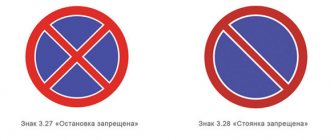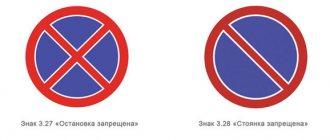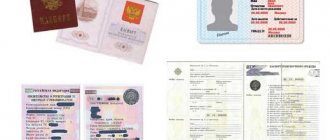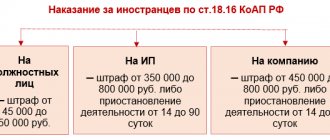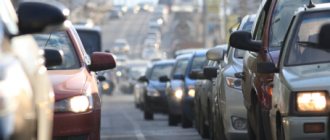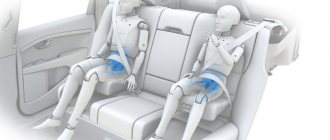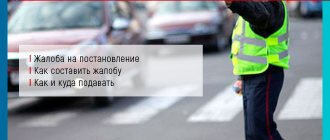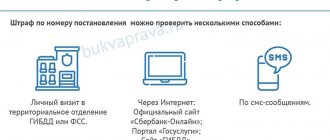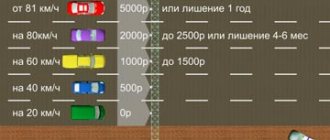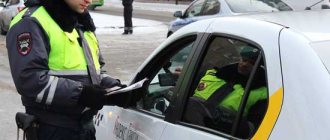How do you know if you have fines? How and where to pay a fine with a 50% discount? What is the statute of limitations for fines? How to challenge traffic fines? These and other similar questions often concern motorists. In this article you will find the answers.
Any driver sooner or later commits a violation of traffic rules, which is recorded automatically by a traffic police officer or traffic cameras. And even if the violation was not committed intentionally, the law requires the execution of the fine.
From the article you will learn:
- Fines from cameras and fines from an inspector: what's the difference?
- What fines are recorded by cameras?
- Where and according to what rules are cameras installed to record violations?
- What to do if you have been fined
- How to appeal a fine
- Traffic fine payment deadline
- Statute of limitations for traffic police fines
- Where to check fines and how to pay them
- How to pay a fine with a 50% discount
- How to control fines for legal entities
Fines from cameras and fines from an inspector: what's the difference?
Fines for violations recorded personally by the inspector and for violations caught on camera differ in the way they are issued.
The inspector draws up a protocol and/or resolution directly against the violator. When registering, the details of his passport or driver’s license number are recorded.
The fine recorded by the camera is issued to the owner of the car, so in the database it is linked to the number of the car’s registration certificate.
Therefore, if you lent a car to a friend, and he violated traffic rules on camera, a fine will come to you as the owner of the car.
It is important to know this, because when checking fines, for example, on the traffic police website.rf in the search results you will see:
- fines from cameras or from an inspector, issued specifically to you and for your violations;
- fines from the camera against you, as the owner of the car, although the violator could, for example, be your son or wife;
- fines from an inspector against another person to whom you lent your car.
If you don’t figure it out right away, you may end up paying more than just your fines. Some popular services, for example, a mobile application, help differentiate fines and avoid paying them for someone else.
Here you can find the complete and current table of traffic police fines 2021.
In what cases is it not necessary to pay?
- If the fine system works slower than usual, the offender can avoid unnecessary expenses.
- The resolution will not come into force if it was appointed 2 months after the commission of the offense.
- If 3 months after the court decision the fine has not been assessed, then you can also forget about it.
However, you should not hope that your offense will be forgotten.
Don’t wait until 2 years have passed, but pay the fine on time with a 50% discount. If the fine is overdue, what should I do? What will be the late fine?
What fines are recorded by cameras?
Drivers have long been accustomed to the fact that cameras can record speeding, crossing a continuous road and driving into oncoming traffic. However, modern video recording tools are already able to recognize other violations on the roads:
- Driving on the side of the road. For such a violation, the driver will receive a fine of 1,500 rubles. In this case, the camera cannot be fooled by the emergency lights being on. Parking cameras have already come to the aid of stationary cameras in this matter, although so far only on the Moscow Ring Road.
- Driving through the parking lot. As with driving on the side of the road, some drivers use the space of parking spaces to avoid traffic jams. In Moscow, along with the fine, violators receive a storyboard from a camera, which proves that the car was moving in the parking lot, and not parked there.
- Driving in the public transport lane. In the regions, the fine for a “bus lane” is 1,500 rubles, in Moscow and St. Petersburg - 3,000 rubles.
- Entering a busy intersection. If there is a waffle marking at such an intersection, most likely it is being filmed by a camera. It will detect a car that entered the waffle at a prohibitory traffic light and stayed there for more than 5 seconds.
- Violations at pedestrian crossings. Cameras on zebra crossings have learned to record and analyze several factors: how much time the pedestrian spent at the crossing, how fast he was moving along the zebra crossing, how fast the car was moving, whether he slowed down in front of the zebra crossing, whether the trajectories of the pedestrian and the car intersected.
- Violations at railway crossings. Here, cameras also record different types of violations: passing the tracks when the barrier is closing or closed, driving through a red light and stopping on the tracks.
- Driving through a red traffic light. This will result in a fine of 1,000 rubles, and for each repeated similar violation - 5,000 rubles. If a car crosses the red stop line but stops, the driver will get off with a fine of 800 rubles. At the same time, as is clear from the previous paragraph, reverse gear will not save you.
- Parking in a prohibited place. Cameras monitor violations of the requirements of the “No Stopping” and “No Parking” signs. Cameras are also installed in front of public transport stops.
- Unpaid parking. In Moscow, this is recorded by stationary “Street Falcons” and parking lots. Fines differ in different regions, but almost everywhere they are impressive. For example, in the capital - 5,000 rubles, in St. Petersburg - 3,000 rubles.
- Unfastened seat belt and talking on the phone while driving. Several traffic cameras in Moscow have learned to notice such violations. Photos of drivers whom the neural network suspects of violating are still checked manually by data center employees, and only then are they sent or not sent to the traffic police.
- Lack of MTPL policy and technical inspection. Cameras can already detect cars whose drivers have not taken out a compulsory motor liability insurance policy. However, inaccuracies in the combined database of insurers and the traffic police are still preventing this from being put into production. The issuance of fines for the absence of a diagnostic card using cameras will presumably begin in 2022. It is planned that the cameras will record the violation once a day until the driver passes the technical inspection.
- Violation of the self-isolation regime. It was planned that by the end of 2020, mobile cameras in Moscow would be trained to identify cars whose owners must comply with quarantine. But since the cameras are still focused on the car data, and not on the driver’s identity, many errors are possible.
Recording from surveillance cameras
In Russia, a special section of the road inspection has been created that deals with these violations. Devices placed on the road record the number and make of the car and immediately send it to the surveillance center. Information is processed by bailiffs. It is sent to the addressee by Russian Post.
Motorists are involved in the following cases obtained from video recording cameras:
- exceeding the established speed limit;
- driving without wearing a seat belt for the driver and passengers;
- driving onto the oncoming road;
- violation of car parking regulations;
- failure to comply with the rules for using public transport lanes.
Something to remember! Video cameras may make mistakes when recording movement. Sometimes the equipment malfunctions and reads the license plate of the wrong driver. If you are confident in your innocence, you must challenge the decision of the traffic police. If you succeed, the court will cancel the fine.
We list the cases when you can challenge a fine issued by an inspector:
- a report was sent for speeding. However, the technical characteristics of the machine do not imply the development of the indicator to such dimensions. In this case, the camera recorded another car and the decision can be safely challenged;
- The photo of the car is blurry, the registration plate cannot be accurately recognized;
- The surveillance camera has not been certified to comply with regulations. In this case, we recommend challenging the imposed fine;
- the car was listed as stolen and was not driven by the owner. If you decide to take advantage of this condition, be sure to present a statement of theft to the court.
- Video equipment is installed in places that are not equipped with special signs indicating changes in driving modes.
Remember! The validity period of fines for video recording is the same as for the personal presence of an inspector.
Where and according to what rules are cameras installed to record violations?
Cameras operating on Russian roads must comply with GOSTs R 57144-2016 and R 57145-2016. They establish requirements for the design features of cameras, their operation and installation locations. According to GOSTs, cameras are installed:
- on sections of roads with limited visibility;
- at railway crossings;
- at intersections of roads with pedestrian and bicycle paths;
- at signalized intersections;
- near educational institutions and crowded places;
- in places where parking or stopping of transport is prohibited;
- on sections of roads with automated weight and size control;
- on roads with a dedicated lane for public transport;
- when changing the speed limit on a section of the road;
- at intersections, roads in the city and outside the city, where more than three accidents with injuries occurred during the year;
- on sections of roads where there are frequent cases of vehicles passing on the side of the road, sidewalk or dividing strip.
A stationary camera can stand alone on an individual stand, or can be mounted on a lamp post, traffic light, road sign or sign, on bridges, overpasses and tunnels. Mobile cameras are installed on roadsides and medians.
If there is a decrease in the number of violations in the place where the camera previously stood, it may be replaced with a dummy one.
Usually, if there is a camera on a section of the road, it is indicated with a sign “Photo and video recording.” But neither the traffic rules nor the GOSTs yet have a mandatory requirement for the installation of such a sign.
The “Photo and video recording” sign refers to signs of additional information, that is, it clarifies the effect of other signs. Accordingly, this sign is not installed separately. According to GOST R 52289-2004, it is placed on traffic lights and road signs 1.1, 1.2, 1.8, 1.22, 3.1-3.7, 3.18.1, 3.18.2, 3.19, 3.20, 3.22, 3.24, 3.27-3.30, 5.14, 5.21, 5.27 and 5.31.
In 2021, the Ministry of Internal Affairs developed changes to the traffic rules, which should introduce a new sign 6.22 “Photo and video recording.” The text of the draft states that the sign will not necessarily be tied to others. It is expected that it will be placed 150–300 meters before the beginning of the control zone and together with signs “Beginning of a populated area.” The document is currently under review. What the new “Photo and Video Recording” sign will look like has also not been determined.
What to do if you have been fined
First, look at the time and place of the violation indicated in the resolution, as well as the photo. Even if you may have been driving on the same road at the time, the photos from the cameras may show a completely different car. The fact is that sometimes cameras do not recognize the license plate correctly.
Also check whether the period for administrative liability has expired. If more than 2 months have passed from the moment of the violation until the decision was made, the fine is already considered invalid and must be appealed. This is discussed in Article 4.5. Code of Administrative Offenses of the Russian Federation.
If the photographs accompanying the decision are still your car, the fine may still be issued unreasonably. It happens that the camera does not capture your car, but a neighboring or some other object. For example, in Moscow, a driver received a decree because the shadow of his car crossed a solid marking line.
And in Tatarstan, the owner of a car that was being transported on a tow truck received a fine for exceeding the permissible speed limit.
In order not to pay a fine for someone else and for camera errors, you need to appeal it in time.
Is it possible not to pay a fine and what will happen for it?
The country's legislation has loopholes, based on which you can avoid paying a fine. However, here too there are certain risks for the violator himself. Thus, bailiffs have the legal right to write off the amount of the fine and an additional 7% from the bank card of the person evading responsibility.
Drivers who believe that the amount of the punishment is not worth the efforts of the bailiffs are mistaken. Therefore, it is practically impossible to wait out peacefully for 2 years. Only a few succeed in this, and, as a rule, it is not worth the nerves spent on evading the FSSP.
Freedom of movement by car may be limited
The rest are faced with the procedure for collection by bailiffs, which is established by law. This means that the initial fine will be increased by at least 1 thousand rubles, and freedom of movement by car may be limited. And if to return the car it is enough to pay a fee, then it is very difficult to return the driver’s license. Deprivation of a driver's license may be lifelong; the terms are determined solely by the court, based on the current situation.
How to appeal a fine
If you are sure that you did not violate the law and the decision was sent to you erroneously, appeal it. A complaint against a decision must be sent to the district (city) court or the official who issued the decision on the case. You can appeal the decision no later than 10 days from the date of receipt of its copy. A sample complaint against a traffic police resolution looks like this:
It is not yet possible to challenge a fine via the Internet in all regions and not for every violation.
Fines from the Moscow Parking Space Administrator (AMPP) can be appealed on the Autocode portal, on the mos.ru website and through a special form on the Moscow Transport website. Fines from MADI are disputed here and through the electronic reception of the Moscow Government.
Russian Post has. It allows you to send a registered letter, including an application to appeal a fine, to the desired department directly from the application or from the Russian Post website. But there is a caveat: if the department is not able to receive letters electronically, they will be printed and delivered in the usual way. So it’s unlikely to work out faster.
Drivers may soon have the opportunity to appeal a fine through State Services. A bill on relevant changes to the Code of Administrative Offenses of the Russian Federation is already under consideration in the Federation Council.
But for now, most Russian drivers are challenging fines the old-fashioned way: by personally submitting a written statement to the agency that issued the fine. For more information about what a statement of complaint should contain, where to send it, what arguments to use, read the article “How to appeal fines from the State Traffic Safety Inspectorate, MADI, AMPP, sample complaints, analysis of situations.”
Traffic fine payment deadline
If you agree with the decision and do not intend to appeal it, then you need to pay for it.
According to the Code of Administrative Offenses of the Russian Federation, the fine must be paid in full no later than 60 days from the date the resolution enters into legal force.
To this period add 10 days allotted for appeal.
If the fine is not paid after the expiration of this period, the materials from the traffic police are sent to the Federal Bailiff Service (FSSP). At the same time, the materials of the administrative case are sent to the court under Article 20.25 of the Code of Administrative Offenses of the Russian Federation “Evasion from execution of administrative punishment”, which provides for a fine of twice the amount of the unpaid fine (but not less than 1000 rubles), or arrest for 15 days, or compulsory labor for up to 50 hours.
After receiving materials from the traffic police, bailiffs initiate enforcement proceedings and give the debtor 5 days to voluntarily repay the debt. If the debt is not paid voluntarily, the amount of the fine is forcibly written off from bank cards, withheld from wages, etc. An enforcement fee in the amount of 7% of the debt amount is added to the existing debt, but not less than 1000 rubles.
Read more in the article “Consequences of non-payment of fines”.
Features of paying fines for traffic violations
A fine is a type of financial punishment that follows the commission of a number of illegal actions, including traffic violations. It can be accrued either automatically from photo and video cameras, or issued by a traffic police officer.
Regardless of the method of calculating the financial penalty, it must be paid within the period established by law.
Moreover, there are no problems with the payment process itself, since it can be done without leaving home. Various services, websites, and mobile banking will help you deposit the required amount on time. They can also be used to check for unpaid sanctions.
Most fines for traffic violations can be paid with a 50% discount. To do this, they must be repaid within 20 days from the date of receipt of the notification of accrual. After the grace period expires, you will have to pay the entire amount specified in the “letter of happiness.”
Any fine can be appealed in the manner prescribed in the Code of Administrative Offenses of the Russian Federation. The violator is given 10 days from the date of delivery of the decision to do this. If the punishment is found illegal, it will be automatically written off.
The law also provides for some mitigating measures for drivers facing serious sanctions. Thus, their repayment can be delayed by a month or divided into several payments. Moreover, after 24 months from the date of entry into force of the punishment, its validity expires. This means that after this period, the person who was issued the fine may not pay it without fear of additional preventive measures, including freezing of personal accounts.
Where to check fines and how to pay them
In accordance with the requirements of the legislation of the Russian Federation, information about all new fines from the traffic police must be sent to the state information system on state and municipal payments - GIS GMP. To check your fines, use any service connected to the GIS GMP. Let's list the most popular ones.
Public services
Only registered users who have filled out information about their driver’s license and car registration certificate in their personal account can check and pay car fines on State Services. Under the same conditions, you can pay fines in the State Services mobile application.
Bank websites and applications
Every bank today offers the opportunity to pay for any services directly from your phone, including fines from the traffic police and other departments. To check whether you have any car fines, it is usually enough to indicate one thing: driver’s license number, vehicle registration certificate or decree number.
Moscow Government website
On the mos.ru website, residents of all regions, not just Moscow, can check and pay fines from the State Traffic Safety Inspectorate, AMPP and MADI. Using your driver's license number, STS number or resolution number, you can see all your fines: paid and unpaid.
Website onlinegibdd.ru
This service is connected to several sources of information, including the GIS GMP, and collects not only traffic police fines, but also fines from MADI and Moscow parking.
To check for unpaid fines, please provide your driver's license or vehicle registration number. Information about payment is sent to the Federal Treasury at the same time the payment is made, so neither you nor the traffic police will have any questions about the timely repayment of the fine. The money ends up in the traffic police accounts within 1-3 business days, and over the next 2 days the fine is usually removed from the traffic police database.
Check car fines
When are fines written off?
In fact, write-off is carried out only if information about the driver for some reason was not transferred to the bailiffs. That is, the traffic police officers issued a resolution and “forgot” about it for two years. It is problematic to imagine such a scenario. But it is possible if there is a failure in the system.
There is one more nuance that fined motorists must take into account. If, in parallel with the monetary penalty, the driver was deprived of his license, then he will be able to return them only after depositing funds into the budget. Yes, the fine will be lost, but the ID will not be returned without a receipt.
If a miracle happens and they “forget” about the fine, then information about them will still remain in the databases. They will be marked as unpaid for which the claim period has expired.
No active actions will affect the duration of the obligation, nor will it affect the change in the status of the obligation.
Thus, the statute of limitations after which the obligation to pay fines disappears is two years. Meanwhile, sending materials to the bailiffs and bringing the driver to justice for evading payment interrupts this period. It will not be possible not to pay if the right to drive is revoked, since a license will not be issued without a receipt.
How to pay a fine with a 50% discount
Part 1.3 of Article 32.2 of the Code of Administrative Offenses of the Russian Federation allows drivers to pay only half of the administrative fine. But such a discount is valid only for 20 days from the date of the decision and not for all types of violations. For example, the discount does not apply to some repeated and serious traffic violations, such as drunk driving or running a red traffic light. The full list of exceptions and the features of providing a discount are described in the article “Traffic police fines with a 50% discount, we share our experience.”
However, in some circumstances, the discount on the fine can be restored even after 20 days from the date of the decision. This is possible if a paper copy of the decision reaches the addressee after the expiration of the twenty-day period. In this case, the driver must file a complaint with the court or the official who issued the decision. Read more about the procedure for restoring a discount on a fine in our article.
The difference between the limitation period and the period of enforcement proceedings
Despite the consonance of the concepts, they have different meanings, which must be taken into account in order to protect one’s own rights.
The limitation period is considered to be the period during which the law allows an individual or legal entity to apply to a court or other legal body in order to protect personal rights that in his opinion have been violated. In this case, the limitation period begins from the moment the decision comes into force, plus ten days to appeal it.
For fines received based on traffic violations, the statute of limitations is 2 years.
The period of enforcement proceedings is the period during which bailiffs must, through procedural and factual actions, force the violator to comply with the conditions specified in the enforcement document. This period is 2 months and cannot be started again earlier than six months from the end of the first one.
How to control fines for legal entities
Legal entities that own a fleet of vehicles often encounter difficulties in tracking and paying fines. It happens that decisions do not arrive on time or are lost altogether. Often it is not possible to pay a fine at a discount or appeal it on time. And the more cars in the fleet, the more problems.
It is better not to wait for the decision to arrive by mail, but to periodically check possible fines online yourself. Some popular services like the traffic police website and State Services have drawbacks. For example, State Services do not show photographs of violations, and on GIBDD.rf you cannot find fines according to the organization’s TIN and fines from MADI and AMPP. Both services do not have tools for paying fines by non-cash method; it is impossible to control the repayment of fines and track the history of fines.
In order not to waste a lot of time tracking and paying the organization’s car fines, many large corporate fleets, carriers and leasing companies use the Online State Traffic Safety Inspectorate super service. Users of the super service only need to fill out information about all the cars in the fleet once, so that in the future they do not have to manually check fines for each of them, pay for them online in a convenient way and control their repayment. The service can be integrated with the organization’s accounting system, and you can also set up automatic notifications of new fines via SMS or email.
Read more about the features of different services for legal entities for monitoring car fines in our article “Staff traffic police fines for legal entities - how to start monitoring all decisions.”
Checking fines for legal entities. persons
Do you want to monitor fines, receive a daily report on new fines found and pay them?
Try for free
Don't miss new useful publications
We will tell you about the intricacies of the legislation, help you understand it and tell you what to do in controversial situations.
